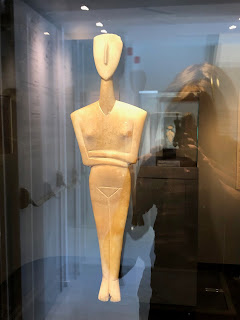I've cycled in the Green Mountains, Adirondacks, Catskills, Sierra Nevada, Pyrenees, Alpes Maritimes and the Alps of France, Italy and Switzerland. I've also done some challenging climbs in places like the Greek island of Milos, where the road up the mountain, I think, was first built long, long before I was born and simply paved over.
I don't know whether that climb was tough (but rewarding) because of the less-advanced state of engineering at the time it was first carved out, the hot weather or my age. But it felt nearly as arduous, at times, as one stretch of the Col de Portillon, on the Spanish border. I climbed it--and was both terrified and exhilarated by the views from the guardrail-less virages--on a bike loaded with full panniers. I don't know whether that stretch--about a kilometer of a 10 kilometer climb --was steeper than the most vertical stretches of the Alpe d'Huez or Col d'Agnel (a.k.a. Colle d'Agnello: It's on the Italian-French border) but I remember a group of people applauding me when I made it to the top.
Well, there is one climb that claims to put those, and all others, to shame. Every year, the Mount Washington Auto Road Bicycle Hillclimb takes cyclists to the top of the highest peak in the Northeastern United States. The route can lay claim to one of the world's steepest climbs: The average grade is 12 percent; extended sections rise at 18 percent and for one part near the end, cyclists have to pump their way up a 22 percent climb.
When bumper stickers proclaim, "This car climbed Mount Washington," you know it has to be quite ride for cyclists. (The road is closed to auto traffic on the day of the ride.) What makes the ascent all the more laborious is the weather, some of the most severe and changeable in the world. For years, the race was held in September, but cold, wind, rain and snow caused organizers to move it to August--where there is still a chance of starting off in typically summer-like conditions but pedaling through cold, wind and freezing rain before reaching the top.
 |
| At the start of the 2017 ride. Photo by Joe Viger |
Mark Greenleaf would know. He plans to participate for the 35th time when this year's edition is held on 20 August.
In 1983, he was living in Providence, Rhode Island when, one day, he grabbed the mail before going out to dinner with friends. Among that day's delivery was a copy of Bicycling! magazine, in which he noticed an article about the ride. "After a couple of beers, we dared each other to do it," he said of his friends at that fateful dinner. The following year, he did it for the first time.
After each climb--which he completed--he always felt it was "agonizingly rewarding." I could say the same for the climbs I've made.


















































